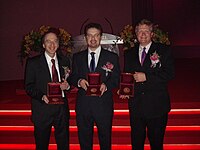Saul Perlmutter

Saul Perlmutter, youq 2011 nienz ndaej Nozbeiwj vuzlijyoz ciengj.
Saul Perlmutter was born one of three children in the Jewish family of professor emeritus of chemical and biomolecular engineering at University of Pennsylvania Daniel D. Perlmutter and professor emerita of Temple University’s School of Social Administration Felice (Feige) D. Perlmutter (née Davidson).[1][2] His maternal grandfather, the Yiddish teacher Samuel Davidson (1903–1989), immigrated to Canada (and then with his wife Chaika Newman to New York) from the Bessarabian town of Floreşti in 1919.[3]
Perlmutter spent his childhood in the Mount Airy neighborhood of Philadelphia attending Greene Street Friends School for the elementary grades, followed by Germantown Friends School for grades 7 through 12.[4] He graduated with an AB in physics from Harvard magna cum laude in 1981 and received his PhD in physics from the University of California, Berkeley in 1986. Perlmutter's PhD thesis titled "An Astrometric Search for a Stellar Companion to the Sun"[5] described the development and use of an automated telescope to search for Nemesis candidates under Richard A. Muller.[6] At the same time, he was using this telescope to search for Nemesis and supernova, which would lead him to his award winning work in cosmology.[7] Perlmutter attributes the idea for an automated supernova search to 1968 Nobel laureate Luis Alvarez, who shared his idea with Perlmutter's research adviser.[7]
Perlmutter heads the Supernova Cosmology Project at Lawrence Berkeley National Laboratory. It was this team along with the competing High-z Supernova Search Team led by Riess and Schmidt, which found evidence of the accelerating expansion of the universe based on observing Type Ia supernova in the distant universe. Type Ia supernova occurs whenever a white dwarf star gains enough additional mass to pass above the Chandrasekhar limit, usually by stealing additional mass from a companion star. Since all Type Ia supernovae are believed to occur in essentially the same way, they form a standard candle whose intrinsic luminosity can be assumed to be approximately the same in all cases. By measuring the apparent luminosity of the explosion from Earth, researchers can then infer the distance to supernova. Comparing this inferred distance to the apparent redshift of the explosion allows the observer to measure both the distance and relative velocity of the supernova.
The Supernova Cosmology Project concluded that these distant supernovae were not receding as quickly as would be expected due to the Hubble expansion alone, and, by inference, the expansion of the universe must have been accelerated over the billions of years since the supernovae occurred. The High-z Team also came to a similar conclusion. The two teams' reports were published within weeks of each other, and their conclusions were readily accepted by the scientific community due to corroborating theories.[8] This conclusion has subsequently been supported by other lines of evidence. These findings initiated new lines of research to understand the nature of the universe, including the exploration of dark matter.[8] For this work Perlmutter was awarded the 2011 Nobel Prize in Physics, shared jointly with Riess and Schmidt.[8]
Perlmutter is also a lead investigator in the Supernova/Acceleration Probe project, which aims to build[9] a satellite dedicated to finding and studying more supernovae in the distant universe. This will help to better constrain the rate at which the universe is accelerating.
He is also a participant in the Berkeley Earth Surface Temperature project, which aims to increase our understanding of recent global warming through improved analyses of climate data.
Perlmutter is a professor and currently teaches at UC Berkeley.


In 2002, Perlmutter won the Department of Energy's E. O. Lawrence Award in Physics. In 2003, he was awarded the California Scientist of the Year Award, and, in 2005, he won the John Scott Award and the Padua Prize. In 2006, he shared the Shaw Prize in Astronomy with Adam Riess and Brian P. Schmidt.[10] The same year, Perlmutter won the Antonio Feltrinelli International Prize.
Perlmutter and his team shared the 2007 Gruber Cosmology Prize (a $500,000 award) with Schmidt and the High-Z Team for discovering the accelerating expansion of the universe.
In 2011, Perlmutter and Riess were named co-recipients of the Albert Einstein Medal.
Perlmutter shared the 2011 Nobel Prize in Physics with Riess and Schmidt.[10] The Nobel Prize includes a SEK 10 million cash award (approximately USD 1.5 million). Perlmutter will receive one-half of the cash prize, while Riess and Schmidt will split the other half.[10]
Saul Perlmutter has two sisters: Shira Perlmutter (b. 1956), a lawyer, and Tova Perlmutter (b. 1967), a nonprofit executive. He is married to Laura Nelson, an anthropologist at Cal State East Bay, and has one daughter, Noa.[11]
- ↑ Daniel D. Perlmutter
- ↑ "Social Work Honors Its Own at Reunion". Archived from the original on 2011-09-30. Retrieved 2012-05-06.
- ↑ Samuel Davidson, led Yiddish revival
- ↑ 模板:Cite news
- ↑ Saul Perlmutter. "An Astrometric Search for a Stellar Companion to the Sun" (PDF).
- ↑ 引用错误:
<ref>标签无效;未给name(名称)为Goldhaber09的ref(参考)提供文本 - ↑ 7.0 7.1 模板:Cite news
- ↑ 8.0 8.1 8.2 Palmer, Jason (2011-10-04). "Nobel physics prize honours accelerating Universe find". BBC. Retrieved 2011-10-05.
- ↑ Build
- ↑ 10.0 10.1 10.2 模板:Cite news
- ↑ "Scientist Discovers The Genuine Dark Side". Contra Costa Times.
